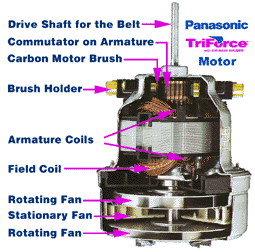The suction motor is one of the most important parts of a vacuum cleaner. It is this motor which takes the electrical power from the power source and converts it into mechanical power in the form of suction with air flow. Rating the motor for its ability to produce suction with air flow is one of the most misrepresented and misunderstood aspects of vacuum cleaner technology. This confusion has been accentuated by many manufacturers in their attempt to make their products appear superior to others. Various methods of rating the suction motor's performance are discussed in the article on the Power of the Suction Motor. This article will focus more on the physical aspects and attributes of the suction motor.

Some technical terms associated with the suction motor include universal, series and brush type. All suction motors, except for the very small battery operated motors, are universal type motors since they can operate with either AC (alternating current) or DC (direct current) power sources. Typically they are designed for best performance with AC at the normal household voltage. This type of motor consists of a rotating armature and a stationary field. The armature is made of a laminated iron core which is wound with copper enamel-insulated wire. The windings are attached to a copper commutator near one end of the armature. The commutator has individual bars of copper which are positioned in the shape of a drum. The motor brushes are carbon rods which are held against the commutator in order to carry the electrical current to the windings on the armature. The field consists of a laminated iron frame on which one or two coils of copper wire are wound. It is shaped so that it wraps around the core of the armature on two opposite sides. Since the same current passes through the field coils and the armature coils, it is termed a series motor. As current passes through the coils in the field and armature, magnetic fields are created by each of them. It is the attracting or repelling of these fields which cause the armature to rotate within the field. The fan is often considered an integral part of the suction motor since it, the fan housings and the motor are assembled as a unit by the manufacturer.
Being a series type motor it is capable of creating high levels of torque for its size. You will find series type motors commonly used in electric shavers, food mixers, electric drills and other portable electric power tools. As current increases through the motor, the magnetic fields created by both the armature and field increase proportionally. Therefore, with lighter loads, the torque is proportional to the square of the amount of current flowing through the motor. If the current is doubled, the torque is increased by four times. Under heavy loads the field's magnetic strength reaches a point of saturation whereby it can no longer increase. Then the torque increases only in proportion with the change in the current flow. Suction motors are designed to operate at very high speeds under moderate to heavy loads.
The load to the suction motor is an interesting and unusual phonomania. One or more fans are attached to the motor shaft and are rotated at a very high speed. The air entering the fan near the hub is forced to spin with the fan as it passes through it. The load to the motor is the force needed to overcome the inertia of the air as it enters the fan and is spun. When you reduce the air flow through the motor by increasing the resistance to the air flow, the load on the motor is actually reduced so the motor speed increases and amperage through it decreases. The effect of this is to increase the suction created by the motor which helps to counteract the effect of the resistance to the air flow. If you restrict the air flow completely, it will create its maximum possible suction. This happens when a sealed suction gauge is used. In essence, it is greater than the suction which is produced in the normal operating range of the motor.
Suction motors on most vacuum cleaners typically draw seven to twelve amperes (amps) of current from the electrical power source. (Twelve amps is the maximum permitted for any appliance which plugs into a standard household electrical outlet. If you see a rating larger than twelve on a vacuum cleaner, it is probably an Cleaning Performance Rating, not amps!) A substantial amount of energy is dissipated in the form of heat. This is primarily the result of resistance in the copper windings on the armature and field as current flows through them. Vacuum cleaners, like traditional uprights, which do not remove the dirt from the air before it passes through the fan use what is known as a bypass cooled motor. A separate fan circulates clean air around the armature and field to cool them. This design is also used on almost all commercial tank and wet/dry vacuum cleaners since it is unsafe to pass damp or wet air over the electrical components. Most household canisters (and power teams) and clean-air system uprights use a flow-thru cooling design. Since the air reaching the fans is already quite clean in these systems, it is directed around the armature and field to cool them after it exits the fans. This makes for a typically quieter operation. Since the motor could overheat if the air flow is greatly or completely restricted, a means is often provided to either stop the motor at a preset temperature or open a safety valve to allow for extra air flow to cool the motor.
Next Vacuum Cleaner Component: Fan or Impeller Types & Performance












